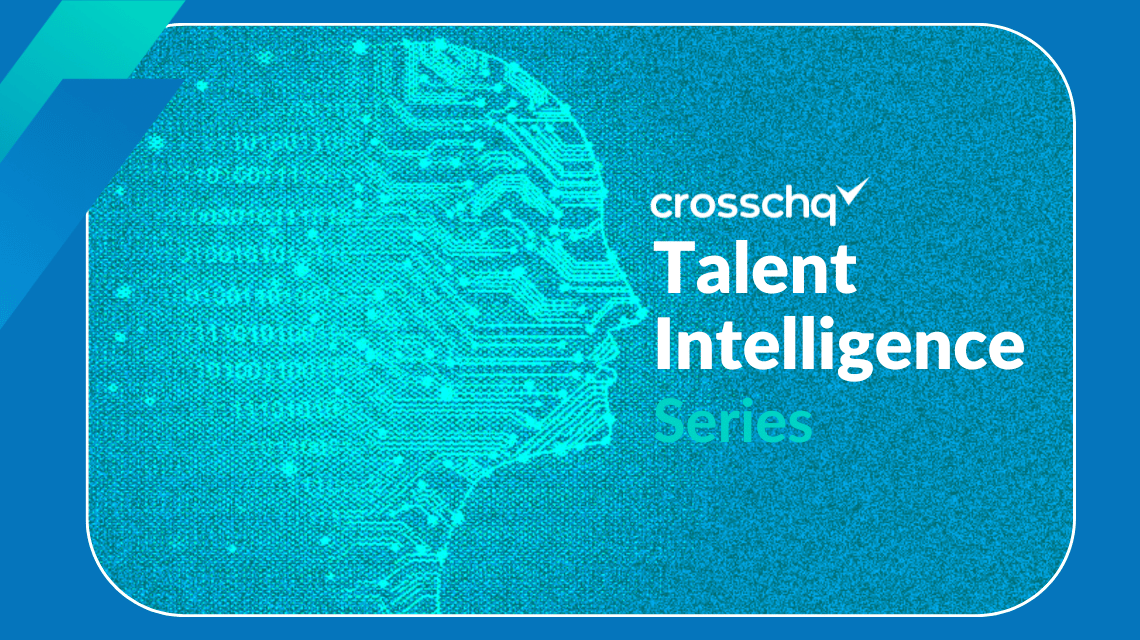

Crosschq Blog
Talent Intelligence Strategy: Smarter Hiring = Long-Term Retention

Talent intelligence strategy should be the driving force behind every talent-related action, from acquisition to recruitment to retention. It helps you hire smarter and keep quality talent longer, improving and futureproofing your workforce.
The right talent intelligence strategy can stop employee turnover in its tracks. The trick is knowing what data is applicable to talent retention and acting on it.
Talent intelligence vs acquisition vs recruitment
Talent intelligence is the broadest term for a strategy that envelops all of the hiring, from role creation to job filling to keeping employees happy. Without talent intelligence, data-driven hiring can be impossible.
Some companies use a talent intelligence platform to try and surface insights from all of the data they have collected on their current employees and potential candidates. Others use talent intelligence tools to upgrade their existing ATS and CRM systems to deliver automation and AI capabilities.
Whatever your path towards talent intelligence looks like, the end goal is the same: To help your organization hire the best possible talent for the role, the responsibilities, the team, and the company vision - and then to keep those employees as long as possible.
Talent acquisition
Part of what you use hiring intelligence for is your talent acquisition strategy. Acquisition covers everything from competitor research to labor market intelligence. It helps you not only find ways to acquire talent but informs what you need that talent to look like and where to find it.
Your talent acquisition strategy can include tools you use to accomplish your goals, like your ATS, and your workforce planning, to help position key employees for long-term value retention. It also covers your internal promotion strategy, making passive sourcing a cornerstone of your approach.
Talent recruitment
Finally, talent recruitment is the nuts and bolts of the actual process of hiring. This includes creating and listing job postings, hiring recruiters, developing job descriptions, and following all of the steps required to bring a new hire into the fold.
From background checks to actual onboarding, recruitment is focused on getting a candidate from the talent pool inside your organization. Starting from the early days of talent search, recruitment doesn’t end until the new hire is fully integrated into your company culture and ramping up to reach full productivity.
[See 6 Things Your Talent Intelligence Tools Must Do to Hire the Right People, Faster]
How to use data to power your talent intelligence strategy
In the context of business, intelligence is actionable knowledge that requires data. Where you get your data can vary; you may be bringing in data points on candidates from online and offline sources and saving them in your ATS and CRM systems.
The point is to collect and organize your data, then analyze it and obtain insights that can be used to drive decisioning. Talent intelligence is derived from your data, while simultaneously making it possible to make sense of that data.
The best types of data to feed your talent intelligence strategy when it comes to planning for better workforce retention include:
Data about your current employees
This includes hire date, skill sets, assessment and survey results, performance reviews, date of hire, engagement metrics, and more. Knowing as much as possible about who is already in place within your organization can help you determine:
- Their value to your company
- How much it would cost to replace them
- What level of risk they carry for churn
- Their potential for greater things within your organization
- Their level of engagement
Data about potential candidates
This includes the standard data available from their resume, including education, certifications, and employment history, but doesn’t stop there. Dig deeper with candidate assessments and digital background checks to find out:
- Their value on the open talent marketplace
- What they need and want from their job and workplace
- What they can add to your company culture
- Whether or not they work well as part of a team
Data about the current trends in compensation and benefits
In addition to the data about who people are and what they can do, you need data on what they want and what they need. In many industries, employees are leveraging a tight labor market to ask for - and get - what they really desire from their job and workplace, and surprise: it’s not always just higher pay.
In fact, employees are willing to take a pay cut in many instances if it means more freedom about when and from where they work, and more autonomy in how that work gets done. Many companies are also moving to a production-based model, meaning as long as an employee gets their work done to a satisfactory quality level, and gets it done on time, the how, when, and where are irrelevant.
This can be crucial data to have on hand if you notice a pattern of employee churn associated with dissatisfaction with, say, a commute or long hours. Being flexible with employee work setups could be a gamechanger in positioning your company not just for employee retention, but for acquisition as well.
[See 6 Ways to Use Talent Intelligence Tools]

Examples of talent intelligence strategy
You can utilize talent intelligence strategy to leverage all phases of the talent acquisition and recruitment process for smarter hiring. The ultimate goal should be two-fold: to hire the best candidates available for any given opening, and to ensure that they will stay hired as long as their value for your organization holds.
Uncover what employees like and dislike about their work environment
A 2021 survey from Willis Towers Watson found that 61% percent of respondents were having a hard time keeping employees, with a similar number seeing the problem continuing in 2022. Talent intelligence can empower employers to understand what factors are most important to their employees, then make sure these areas are prioritized as part of a robust and proactive retention strategy.
Talent intelligence can use surveys to focus on potential issues employees may be having in the workplace, from difficulties communicating with HR to managerial styles. This can highlight things in your organization that needs to change, eliminate negative word of mouth and provide opportunities for positive reviews of your company as a good place to work.
Improve diversity in the workforce - and be transparent about it
A survey of 2,000 American knowledge workers discovered that 86% of employees surveyed said a diverse workforce is important. However, barely a third of HR directors said they feel the same way, indicating a gap between HR and employees in understanding the importance of issues around DEIB.
Talent intelligence can help surface these issues and show how well a company is doing at communicating its commitment as well as following through. Understanding what attracts top talent and what repels high-value workers is pivotal to employee acquisition and retention. By leveraging talent intelligence strategies, tools, and systems, HR professionals can reveal which employee engagement areas to concentrate efforts on in order to retain their top talent.
Strategize for the future of the workforce
How companies conduct business is changing rapidly, and organizations need to address these changes in their business planning. Talent intelligence can help your organization strategize for the future by gathering vast datasets together and analyzing them to uncover hiring and retention insights.
From where your employees come from before you hire them, to where they go after they leave your employ, data can tell you a lot about talent trends and where the labor market is headed. You’ll be able to discover what your competitors are doing to attract talent, which compensation packages work best for what type of employee, and where you need to focus your recruitment efforts to leverage the most fruitful talent channels.
Reporting on seemingly small details - like asking a new hire what the best and worst part of their interview was - can help you spot patterns that could be impacting quality of hire and retention. From there, you can develop better processes and strategies to optimize your hiring processes.
Identify and leverage internal mobility opportunities
A large part of talent intelligence focuses on acquisition and recruitment, but it’s also critical for effective nurturing of existing employees at every stage of their career. Having comprehensive data about your employees, their skill sets, their interest in learning and development initiatives, and their growth plans can help you figure out if the talent you really need is already within your company.
Talent intelligence can help identify and uncover internal candidate achievements, work experience, and qualifications that may not be in their file. You can use these and other candidate quality indicators to gauge how existing employees compare to one another and to candidates in the wider talent pool.
Surfacing opportunities to promote from within leads to heightened employee loyalty and prolonged retention. By leveraging talent intelligence to help employees develop and grow, you can increase the likelihood that the team members you have already invested in will stay with the business.
Crosschq for talent acquisition and retention
It’s time to start hiring for retention. Talent Intelligence technologies can ensure data-driven recruiting and promotion processes are in place. Crosschq provides three ways to help you hire for retention: /Homepage%20Hero%20(3).png?width=600&name=Homepage%20Hero%20(3).png)
- Crosschq 360, which helps remove bias from the candidate screening process via digital reference checking
- Crosschq Recruit, which provides a high-value talent pipeline full of candidates ready to hire and get to work
- Crosschq Analytics, which can help surface insights from employee data that can help flag potential churn triggers
All of these can help improve hiring and retention rates. For more information, contact a talent specialist for a free demo today.
Take the Guesswork
Out of Hiring
Schedule a demo now



%20-200x43.png)





